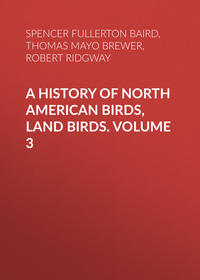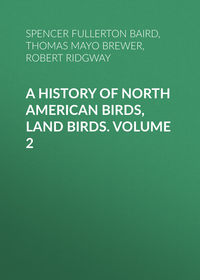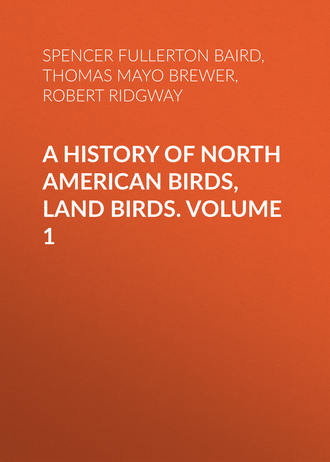 полная версия
полная версияA History of North American Birds, Land Birds. Volume 1
Hab. Coast of California, near San Francisco; “Russian America, Kodiak” (Bonaparte).
This is the most strongly marked of the several races of P. savanna, differing from all the others in several important respects. The markings beneath are more generally dispersed, extending back upon the lower part of the breast, and forward over the throat; the lower tail-coverts have distinct medial blackish streaks, though they are somewhat concealed. The median stripe on the crown is decidedly greenish-yellow, not pale ashy; the whitish edges to the interscapular feathers, so conspicuous in the other races, are more concealed, presenting a more uniformly brown surface above, with broader black stripes. The broad lateral stripes of the crown are deep olive or hair-brown, with narrow, sharply defined, intense black streaks, instead of pale grayish as in alaudinus (spring dress), or light brown as in savanna (spring), with broader, less deep, black streaks.
Habits. The Shore Sparrow of California is said to be, to a remarkable degree, the peculiar marsh species of the Pacific coast of that State. Dr. Cooper states that he very rarely met with these birds out of the salt marshes, where they lie so close and run so stealthily among the weeds that they are flushed with difficulty. They rise only to fly a few rods, and drop again into their covert. They are not at all gregarious, except when migrating, and are found singly or by pairs. They are abundant about San Francisco in the winter, though Dr. Cooper is not sure that any are found so far south in the summer. Near San Diego, in February, they had already begun to utter their short and pleasant song, as they perched on the top of some tall weed. Dr. Cooper observed them in that neighborhood into April, but did not succeed in finding any of their nests, nor was he ever able to meet with this species at San Pedro in summer.
Dr. Coues speaks of (Ibis, 1866, p. 268) finding three species of the difficult group of Passerculi, and all of them very abundant, in Southern California in November. These were P. rostratus, P. alaudinus, and P. anthinus. The anthinus seemed confined to the moist salt grass and sedgy weeds of the sea-shore itself. It was flushed with great difficulty, and then its flight was very rapid and irregular. It would alight again almost immediately, and run with great celerity among the roots of the thick grasses, and was therefore exceedingly difficult to procure. P. alaudinus was common two or three miles away from the coast, but Dr. Coues did not find one mixing with P. anthinus. It was a brush and weed, rather than a grass, species, associating with Anthus ludovicianus and Zonotrichia coronata.
Passerculus princeps, MaynardIPSWICH SPARROWCentronyx bairdi, Maynard, Naturalist’s Guide, 1870, 117, frontispiece (Ipswich, Mass.). Passerculus princeps, Maynard, American Naturalist, 1872.
Sp. Char. Bill small, exactly the same in form and size as that of Centronyx bairdi; but proportionally smaller; tertials scarcely exceeding the secondaries; tail emarginate, the feathers acute, the intermediæ attenuated terminally. Outstretched feet reaching about half-way to the end of the tail. In color almost exactly like P. rostratus, but different in markings. Above light ashy, the dorsal feathers light sandy-brown centrally, producing an obsoletely spotted appearance; shafts of dorsal feathers black. Outer surface of the wings pale sandy-brown, the feathers darker centrally; tertials with their outer webs whitish, and with a conspicuous black central area. Crown becoming darker brown anteriorly, where it is divided by a rather indistinct line of ochraceous-white; an indistinct superciliary stripe, and a very conspicuous maxillary stripe of the same; the latter bordered above, from the rictus to the end of the auriculars, by a narrow stripe of dusky; lores and sub-orbital region like the superciliary stripe; auriculars pale brownish like the crown, bordered along the upper and lower edge with a dusky narrow stripe. Beneath white, slightly tinged with ashy on the flanks; sides of the throat, whole breast, sides, and flanks, with narrow streaks of sandy-brown, more blackish toward the shaft; abdomen, crissum, and lining of the wing, immaculate; throat with a few minute specks, but along each side bordered by a “bridle” of suffused streaks.
♂. (Collector’s No. 1,744, Ipswich, Mass. Dec. 4, 1868; C. J. Maynard.) Wing, 3.25; tail, 2.60; culmen, .45; tarsus, .95; middle toe, .80; hind claw, .40.
♀. (Collector’s No. 6,245, Ipswich, Oct. 15, 1871; C. J. M.) Wing, 2.90; tail, 2.40; culmen, .50; tarsus, .85; middle toe, .65; hind claw, .30.
(Collector’s No. 6,224, Ipswich, Oct. 14, 1871; C. J. M.) Wing, 3.00; tail, 2.30; culmen, .50; tarsus, .85; middle toe, .60; hind claw, .30.
The specimens described above were at first supposed to be Centronyx bairdi, having several points of resemblance to that species, a comparison with the type in Professor Baird’s collection at first failing to establish a difference, as it was in faded and much worn summer plumage, while the Massachusetts specimens were in perfect, blended fall dress, so that a satisfactory comparison was almost impossible. A more recent examination, however, with the advantage of two additional specimens of the Massachusetts bird, has fully convinced Mr. Maynard that his specimens are not Centronyx bairdi, and that, indeed, they are referrible in all respects to the genus Passerculus.
In carefully examining the type of Centronyx bairdi, it is seen that its characteristic features are the following: Outstretched feet reaching beyond the end of the tail; hind claw as long as its digit, and much curved;—whereas in Mr. Maynard’s specimens the outstretched feet reach to only about the middle of the tail, while the hind claw is much shorter than its digit, and only slightly curved. With a wing .10 to .45 of an inch longer, they have the tarsus not any longer, and proportionally more slender. In coloration they are still more different. The most striking feature in C. bairdi is a broad and very conspicuous median stripe of ochraceous-buff on the crown, bordered on each side by an aggregation of black streaks, which form the predominating color of the lateral stripes; of this median stripe there is scarcely any trace in the specimens under consideration, while the crown generally is grayish-brown, with small dusky streaks; C. bairdi has broad, conspicuous, black stripes on the back, while P. princeps has obsolete sandy-brown ones; in C. bairdi there are only a few small streaks of black across the jugulum and along the sides and flanks, while in P. princeps the whole breast, as well as the sides and flanks, are thickly streaked with broader marks of sandy-brown.
In point of coloration, as well as in the feet, there is in reality a much closer resemblance to Passerculus rostratus; but in this the very different bill and different arrangement of markings are sufficient distinctive characters.
Upon the whole, therefore, there can be little doubt that the present birds are well entitled to the name which Mr. Maynard has given them; for after making all possible allowance for seasonal differences in coloration, we have found it impossible to reconcile them with the C. bairdi.
In this species there is a slight superficial resemblance to Poocætes gramineus; but upon comparison it will be found to be entirely different: thus, P. gramineus lacks the median light stripe on the crown, has the lesser wing-coverts rufous and the lateral tail-feathers white, while the streaks are all blackish and the ground-color different; the generic details, too, are quite different.
Habits. This species has been obtained only in Eastern Massachusetts, where, in the neighborhood of Ipswich, it was found among the sand-hills by the sea-shore. The place where the individuals taken were met with is a rather remarkable tract, three miles in length and nearly one in breadth. It is as treeless as the Great Plains, and as bleak and barren, with no vegetation except a scant growth of coarse grass. Mr. Maynard obtained his first specimen early in December, 1868. Although others were seen, yet this was all he was then able to obtain. He has since taken others in the same place and season. Nothing is known as to its habits. It uttered, as it rose, a short chirp of alarm.
Passerculus rostratus, BairdSAN DIEGO SPARROWEmberiza rostrata, Cassin, Pr. A. N. Sc. VI, 1852, 348. Ammodramus rostratus, Cassin, Ill. I, 1855, 226, pl. xxxviii. Passerculus rostratus, Baird, Birds N. Am. 1858, 446.—Cooper, Orn. Cal. 1, 1870, 184.
Sp. Char. Bill very long (.55 of an inch above). Whole upper parts and sides of head and neck pale brownish-gray (almost fulvous), nearly every feather with a darker central blotch, darkest along the shaft. A scarcely appreciable central stripe in the crown, an obscure yellowish-white superciliary, and a whitish maxillary one. Under parts pure white; streaked on the breast and the sides of throat and body with dark brown (the streak paler externally). Under tail-coverts unspotted white. Tail and wing feathers and wings margined with the color of the back; the edges of tertiaries rather paler. Length, 5.30; wing, 2.90; tail, 2.30.
Hab. Coast of California, south to Cape St. Lucas; mouth of Colorado River (Dr. Palmer).
The bill of this species is very long and conical, the cutting edge nearly straight. The wings are rather long, the tertiaries nearly as long in the closed wing as the primaries; the second, third, and fourth quills longest, the first rather longer than the fifth. The tail is short and emarginate, the feathers narrow, acute, and moderately stiff. The tarsi are long; the claws little curved.
This species resembles the Passerculus savanna rather more than any of the other sparrows with spotted breasts; the bill is, however, very much longer and larger, exceeding any of our American species of its size, the upper outline more convex. Its colors are much paler, and it lacks the yellow on the head and wing. The much shorter tail and entire absence of rufous distinguish it from the spotted Melospizas. In shape the bill is like that of Ammodromus caudacutus, but it is larger; the head lacks the yellow, etc.
In some specimens the streaks on the back are almost obsolete.
Habits. So far as is known, this bird seems to have a somewhat restricted habitat, being apparently confined to the sea-coast of Southern California. There it was first met with by Dr. Heermann, in the neighborhood of San Diego, and was described by Mr. Cassin as an Ammodromus, with which genus of birds it seemed to have many peculiarities in common. Dr. Heermann first met with this bird in 1851, on the shores of the bay of San Diego, in company with other species, apparently in search of grass-seed. Afterwards, in the Pacific Railroad Survey, with Lieutenant Williamson, he again met with these birds in considerable numbers at Santa Barbara and San Pedro. In all the places in which he met with it he found it frequenting low sandy beaches, and the heavy sedge-grass which abounds on the shores. On the former it seemed to be feeding on marine insects and seeds thrown up by the tide, and in the latter to find places for easy and immediate concealment when alarmed or pursued. Naturally it appeared to be a quiet and unsuspicious bird. He heard it utter no other note than a short sharp chirp.
Dr. Cooper thinks this species has a much greater affinity to the Ammodrami than to the Passerculi, both in its bill and claws, as well as in its habits. He found them very abundant, both at San Pedro and San Diego, at all seasons, and he does not think that they migrate at all from those localities. He found them frequenting the shores of the bays and the sea-beaches. They also came confidently and familiarly about the buildings near the water, feeding on any seeds or insects they could find. On the beach they run along the sand, in the rows of drifted sea-weeds, seeking their food, and rarely take to flight unless surprised, and then only fly a short distance. Dr. Cooper has never known them to alight on any bush, nor does he think that they have any song. The only note he has ever heard them utter is a short chirp. At San Pedro he saw them, in July, feeding their young, but he has never found a nest that he was certain belonged to this species.
Dr. Coues found this bird abundant in Southern California, where it kept among the thick weeds of the dry plain, and was much on the ground, where it ran as easily as a Pipilo, often flying up into the bushes and resting there quietly. They were to be seen also in great numbers sunning themselves and catching flies on the piles of lumber on the wharf, so tame as to be almost liable to be struck by a cane.
It is a winter resident at Cape St. Lucas, where Mr. Xantus found them abundant. They were not seen there in summer, though it is probable they reside on the shores in its neighborhood. Their nest and eggs remain unknown.
Passerculus rostratus, var. guttatus, LawrST. LUCAS SPARROWPasserculus guttatus, Lawrence, Ann. N. Y. Lyc. VIII, 1867, 473.—Cooper, Orn. Cal. 1, 185.
Sp. Char. Above plumbeous-gray; the feathers of the back with dusky centres and paler edges; the top of head also streaked with dusky and with an almost inappreciable median stripe of lighter. Upper tail-coverts slightly darker in the centre. No rufous edgings to the feathers. Head with a pale yellowish-white band from bill over the eye; and a mandibular one, nearly white, bordered above and below by the dusky line of other Passerculus. Under parts white, thickly streaked on jugulum, breast, and flanks with dusky, faintly on under tail-coverts. Bill and legs rather dusky; iris brown. Length, 5.00; wing, 2.50; tail, 1.95; tarsus, .80; middle toe and claw, .75; bill above, .51; gape, .56; greatest height, .25.
Hab. Cape St. Lucas (Dec., 1859).
This bird, of which a single specimen only is so far known, is very closely related to P. rostratus, though very easily distinguished from it. It is considerably smaller than rostratus, the bill more slender, the upper parts much darker, being plumbeous, not sandy-colored; the stripes beneath darker; the bill and legs more dusky. These differences may not indicate a distinct species, but as the specimen here described differs entirely from all the specimens of a large number of P. rostratus, it is yet entitled to consideration as a marked variety,—probably the resident race at Cape St. Lucas, where the var. rostratus is merely a winter visitor.
Habits. The St. Lucas Finch is a new species, in regard to the habits of which nothing whatever is as yet known. It was obtained at San José, in Lower California, by Mr. John Xantus, in December, 1859. It was found in company with a flock of Passerculus rostratus, and the presumption is that its habits may resemble those of that little-known species.
Genus POOCÆTES, BairdPoocætes, Baird, Birds N. Am. 1858, 447. (Type, Fringilla graminea, Gm.)
Gen. Char. Bill rather large; upper outline slightly decurved towards the end, lower straight; commissure slightly concave. Tarsus about equal to the middle toe; outer toe a little longer than the inner, its claw reaching to the concealed base of the middle claw; hind toe reaching to the middle of the middle claw. Wings unusually long, reaching to the middle of the tail as far as the coverts, and pointed; the primaries considerably longer than the secondaries, which are not much surpassed by the tertiaries; second and third quills longest; first little shorter, about equal to the fourth, shorter than the tail; the outer feathers scarcely shorter; the feathers rather stiff; each one acuminate and sharply pointed; the feathers broad nearly to the end, when they are obliquely truncate. Streaked with brown above everywhere; beneath, on the breast and sides. The lateral tail-feather is white. Shoulder chestnut-brown.
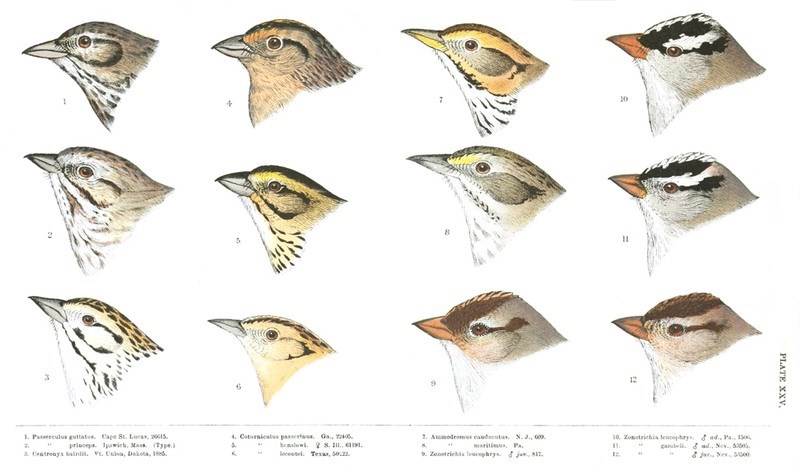
PLATE XXV.
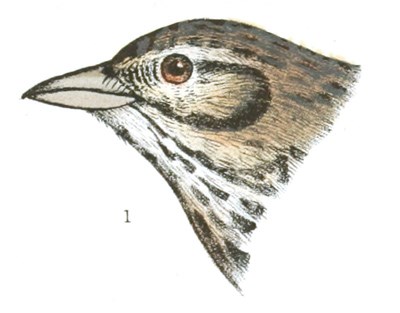
1. Passerculus guttatus. Cape St. Lucas, 26615.
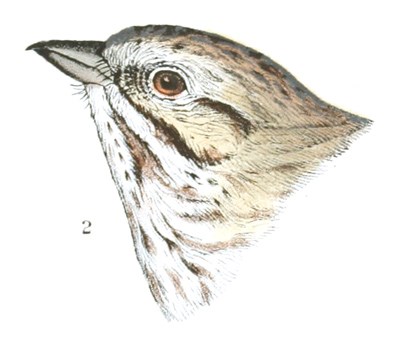
2. Passerculus princeps. Ipswich, Mass. (Type.)
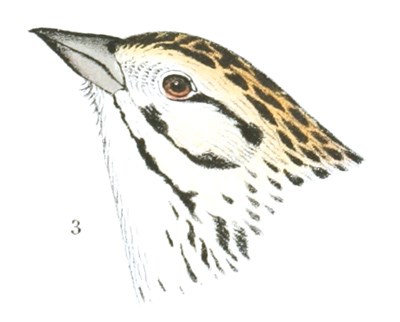
3. Centronyx bairdii. Ft. Union, Dakota, 1885.
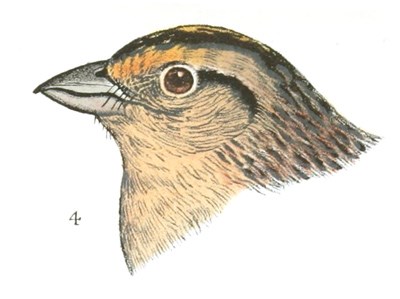
4. Coturniculus passerinus. Ga., 22405.
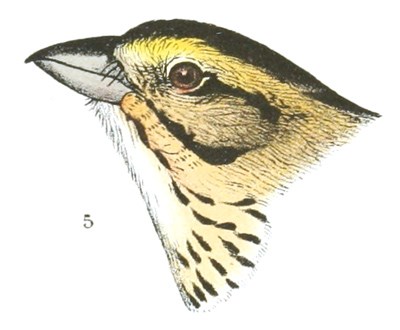
5. Coturniculus henslowi. ♀ S. Ill., 61191.
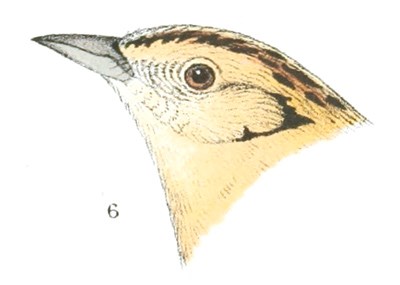
6. Coturniculus lecontei. Texas, 50222.
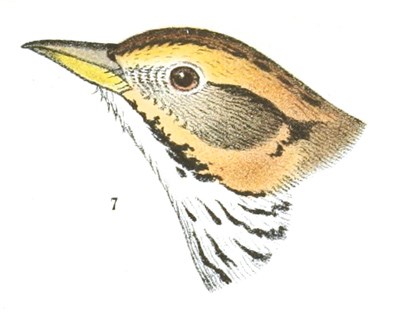
7. Ammodromus caudacutus. N. J., 609.

8. Ammodromus maritimus. Pa.

9. Zonotrichia leucophrys. ♂ juv., 817.

10. Zonotrichia leucophrys. ♂ ad. Pa., 1506.
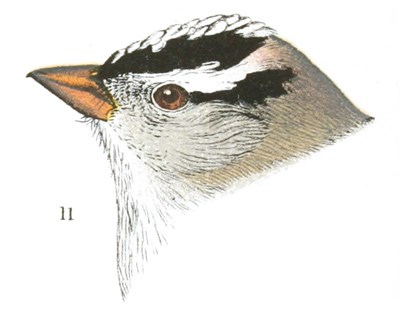
11. Zonotrichia gambeli. ♂ ad. Nev., 53505.
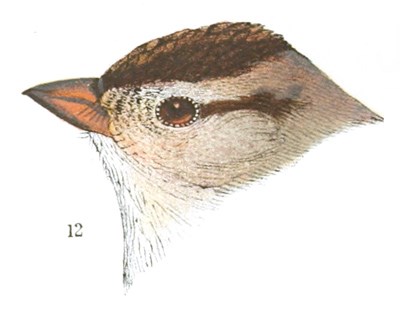
12. Zonotrichia gambeli. ♂ juv. Nev., 53500.
The essential character of the genus consists in the long and pointed wings, longer than the tail and without long tertials; and the rather stiff, forked tail, with its acute feathers. But one species is recognized at present.
Poocætes gramineus, BairdGRASS SPARROW; BAY-WINGED BUNTINGVar. gramineusFringilla graminea, Gm. Syst. Nat. I, 1788, 922.—Aud. Orn. Biog. I, 1831, 473; V, 502, pl. xc. Emberiza graminea, Wilson, Am. Orn. IV, 1811, 51, pl. xxxi, f. 5.—Aud. Syn. 1839, 102.—Ib. Birds Am. III, 1841, 65, pl. clix.—Max. Cab. Jour. vi, 1858, 342. Fringilla (Zonotrichia) graminea, Swainson, F. B. Am. II, 1831, 254. Zonotrichia graminea, Bon. List, 1838.—Ib. Conspectus, 1850, 478. Poocætes gramineus, Baird, Birds N. Am. 1858, 447.—Samuels, 303.
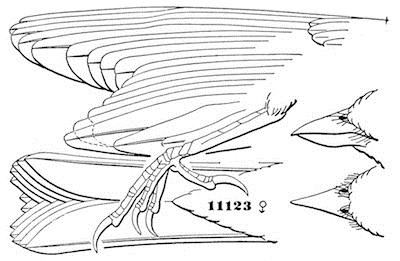
Poocætes gramineus
11123 ♀
Sp. Char. Tail-feathers rather acute. Above light yellowish-brown; the feathers everywhere streaked abruptly with dark brown, even on the sides of the neck, which are paler. Beneath yellowish (sometimes reddish) white; on the jugulum and sides of neck and body streaked with brown. A faint light superciliary and maxillary stripe; the latter margined above and below with dark brown: the upper stripe continued around the ear-coverts, which are darker than the brown color elsewhere. Wings with the shoulder light chestnut-brown, and with two dull whitish bands along the ends of the coverts; the outer edge of the secondaries also is white. Exposed portion of outer tail-feather, and edge and tip of the second, white. Length, about 6.20; wing, 3.10; tail, 2.50; bill, .33 from frontal feathers to point, by .33 in depth at base; tarsus, .72. Bill yellow, dusky above; legs yellow. (Measurement of No. 10,147 ♀, Washington, D. C.)
Hab. Eastern Province of United States.
Var. confinisPoocætes gramineus, var. confinis, Baird, Birds N. Am. 1858, p. 448 (in text under P. gramineus). Poocætes gramineus, Cooper & Suckley, 200.—Cooper, Orn. Cal. 1, 186.
Sp. Char. Resembling P. gramineus, but colors paler, the dark streaks narrower. Bill more slender, tarsi longer. (Measurement of 40,803 ♂, Fort Whipple, Arizona: Bill, .36 from point of frontal feathers by .25 in depth through base; tarsus, .78; wing, 3.35; tail, 2.80).
Hab. Western and Middle Provinces of United States, south into Mexico; Oaxaca (Scl. 1859, 379; March).
This species is readily identified by the absence of a median stripe on the head, the chestnut-brown of the shoulder, and the white lateral tail-feathers. The young birds have the ground-color above more whitish, the streaks blacker, in sharper contrast; the streaks on jugulum, etc., less sharply defined; the general appearance, however, is not different from the adult. Sometimes there is a decided cinnamon wash beneath. Western specimens (var. confinis) appear to be paler, with longer wings, and longer and more slender bills, in this respect resembling other Finches (Melospiza, Passerculus, etc.).
All specimens from west of the Rocky Mountains are to be referred to var. confinis.
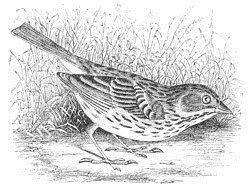
Poocætes gramineus.
Habits. The Bay-winged or Grass Finch is a very abundant species wherever found, and has a very extended distribution. Accepting as one species the slightly variant races above indicated, this bird extends from Florida and Mexico, on the south, to the 57th parallel of latitude, and from the eastern to the western shores. It was found by Richardson frequenting the plains of the Saskatchewan, where it arrives early in May and leaves in September, and where it nests abundantly in the short withered grass of that sterile region. Richardson did not trace it farther north than the 57th parallel, and it was not obtained on the Yukon or Anderson Rivers by Mr. MacFarlane or Mr. Lockhart. It breeds from Northern Virginia north.
In the Middle States it is partially resident, a portion remaining all the winter. South of Washington it is chiefly migratory, only found, in any numbers, from November to March, and probably but few remaining to breed. Audubon states that he never saw any of this species in any portion of Louisiana, Missouri, Kentucky, or Ohio. Mr. Dresser, on the other hand, found them common about San Antonio in August and September, and also in May and June, and had no doubt that some remain to breed.
It is very abundant throughout New England, arriving in some seasons as early as March 11, and remaining until quite late in the fall, often through November. It is found chiefly in dry open fields and pastures, where it nests, with no pains at concealment, on the ground, in depressions made by its own work. It is an unsuspicious and fearless species, neither seeking nor avoiding the companionship of man. It does not usually build near houses, yet is not unfrequently known to do so. It may be often found perched on fences along the roadside, chanting its simple and pleasing lay, and quite as frequently in the road feeding and dusting itself. The latter operation it is very fond of practising, and almost any day in the summer these birds may be found in such situations.
West of the Great Plains is found a marked variety of this species, differing in many respects from the eastern. The western species or race of this Finch, Mr. Ridgway states, is an abundant summer bird in all the elevated grassy portions of the West. It is especially characteristic of the higher grassy slopes of the elevated mountains, particularly in the Rocky Mountain regions, and its sweet and simple song is one of the pleasant associations of those regions. It descends, in the autumn, to the lower districts, having been observed during September in the greatest abundance among the “rye-grass” meadows of Senot Valley, at the northern end of the East Humboldt Range. It nests on the ground in grassy banks, in various situations.




